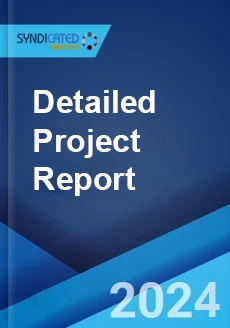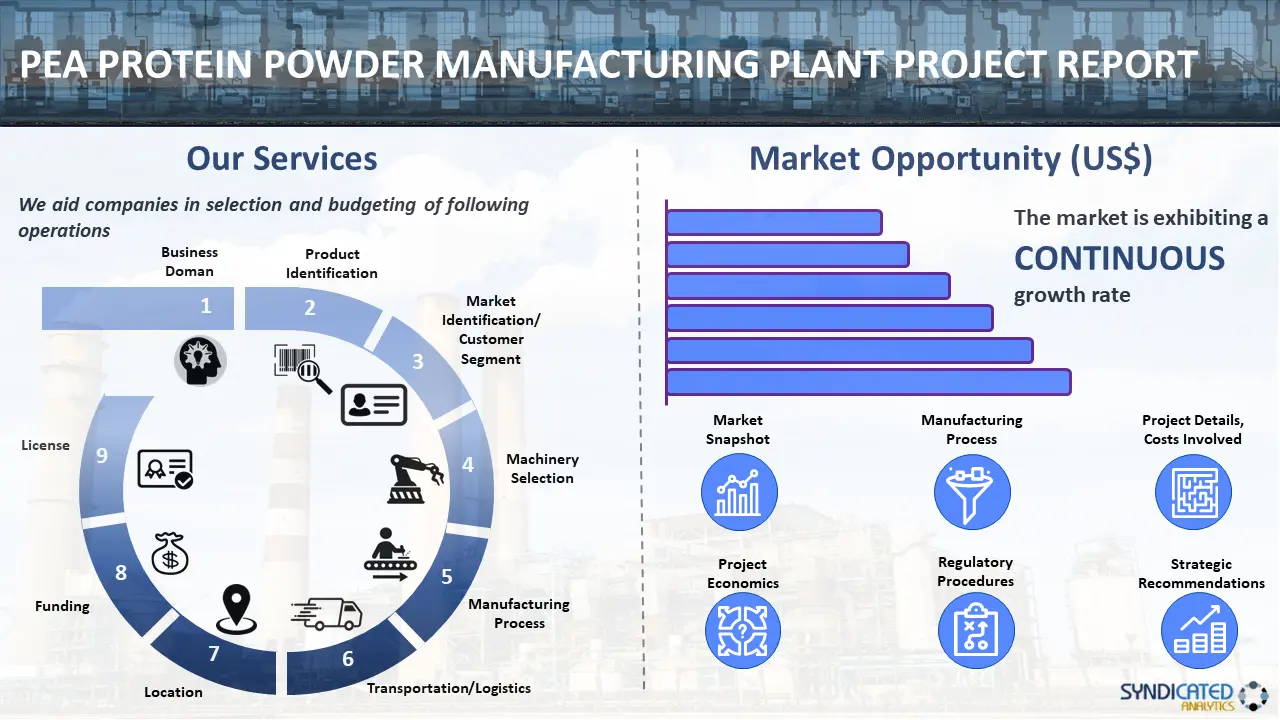
Pea Protein Powder Manufacturing Plant Project Report 2025 Edition
Report Coverage: Industry Analysis (Market Performance, Segments, Price Analysis, Outlook), Detailed Process Flow (Product Overview, Unit Operations, Raw Materials, Quality Assurance), Requirements and Cost (Machinery, Raw Materials, Packaging, Transportation, Utility, Human Resource), Project Economics (Capital Investments, Operating Costs, Profit Projections, Financial Analysis, Revenue), and Investment Opportunities
Report Overview:
The new report conducted by Syndicated Analytics, titled "Pea Protein Powder Manufacturing Plant Project Report 2025 Edition: Industry Analysis (Market Performance, Segments, Price Analysis, Outlook), Detailed Process Flow (Product Overview, Unit Operations, Raw Materials, Quality Assurance), Requirements and Cost (Machinery, Raw Materials, Packaging, Transportation, Utility, Human Resource), Project Economics (Capital Investments, Operating Costs, Profit Projections, Financial Analysis, Revenue), and Investment Opportunities," offers a comprehensive guide for establishing a manufacturing plant in the pea protein powder industry. It encompasses a wide-ranging market overview and delves into specific details such as unit operations, raw material requirements, utility needs, infrastructure prerequisites, machinery and technology specifications, workforce demands, packaging prerequisites, transportation logistics, and more.
Furthermore, this report delivers extensive insights into project economics, including capital investments, project financing, operating costs, income and expenditure forecasts, fixed versus variable expenses, direct and indirect outlays, expected return on investment (ROI), net present value (NPV), profit and loss analysis, and comprehensive financial assessment.

Market Analysis
| Current Demand for Pea Protein Powder | The report evaluates the existing global demand for pea protein powder. |
| Growth Prospects and Trends | The study delves into the growth prospects and emerging trends within the pea protein powder market, providing insights to guide strategic decision-making. |
| Leading Segment and Regional Analysis | This study presents a concise overview of the key segments and regional influence in the pea protein powder market, providing a comprehensive view of the industry's overall landscape. |
| Competitive Landscape | An analysis of the competitive landscape highlights key players in the pea protein powder manufacturing industry, shedding light on their strategies and market positioning. |
A. Introduction
Pea protein powder, derived from yellow split peas, is a high-quality plant-based protein source that has gained popularity among health enthusiasts, vegetarians, and vegans. This environmentally friendly and sustainable protein alternative is produced by drying and grounding peas into a fine powder, which is then processed to remove most of the carbohydrate content, leaving a concentrated protein-rich powder. It is celebrated for its excellent amino acid profile, including all nine essential amino acids necessary for human health, making it a complete protein source that supports muscle growth, repair, and overall bodily functions. One of the advantages of pea protein powder is its easy digestibility and low potential for allergies, making it a suitable option for individuals with sensitivities to dairy or gluten. It's also rich in iron and arginine, an amino acid beneficial for heart health and blood flow. Pea protein's neutral taste and versatility make it a popular ingredient in shakes, smoothies, and various vegan recipes, offering a substantial protein boost without altering the flavor of foods. Moreover, the rise of pea protein powder reflects a broader shift towards plant-based diets, driven by concerns over animal welfare, environmental sustainability, and health considerations.
B. Market Trends/Drivers
The global pea protein powder market is influenced by several key drivers that shape its dynamics and growth trajectory, such as the increasing consumer awareness about the health benefits and nutritional value of pea protein. Additionally, the rising demand for plant-based protein sources, particularly among vegetarians, vegans, and individuals with dietary restrictions, propels the adoption of pea protein powder in various food and beverage applications, contributing to the market growth. Moreover, the growing trend of clean label and natural ingredients in food products stimulates the demand for pea protein powder as a clean and sustainable protein source, further fueling the market expansion. Furthermore, the rising prevalence of lifestyle-related diseases and obesity encourages consumers to incorporate healthier protein alternatives into their diets, driving the demand for pea protein powder as a functional ingredient in nutrition and wellness products. Apart from this, the growing emphasis on sustainable agriculture and ethical sourcing practices in the food industry fosters the cultivation and production of peas for protein extraction, positively impacting market growth.
This report is essential reading for entrepreneurs, investors, researchers, consultants, and business strategists with interests in the pea protein powder industry. It offers a thorough examination of the current state of the industry and its future potential, supplying valuable information for informed decision-making and strategic planning. Serving as an invaluable resource, this report provides a detailed exploration of the pea protein powder industry, making it an indispensable tool for those looking to establish a strong presence in this dynamic sector.
Market Coverage:
| Current Demand for Pea Protein Powder | The report evaluates the existing global demand for pea protein powder. |
| Growth Prospects and Trends | The study delves into the growth prospects and emerging trends within the pea protein powder market, providing insights to guide strategic decision-making. |
| Leading Segment and Regional Analysis | This study presents a concise overview of the key segments and regional influence in the pea protein powder market, providing a comprehensive view of the industry's overall landscape. |
| Competitive Landscape | An analysis of the competitive landscape highlights key players in the pea protein powder manufacturing industry, shedding light on their strategies and market positioning. |
Project Feasibility
| Technical Feasibility | The study outlines the intricacies of pea protein powder manufacturing, outlining the necessary equipment and technological requirements. A clear description of the manufacturing process is provided. |
| Financial Feasibility | The report presents an in-depth financial analysis, including the initial investment required, income and profit projections. These financial insights aim to assist potential investors in assessing the viability of the project. |
| Environmental and Regulatory Considerations | The report also discusses the environmental and regulatory aspects associated with pea protein powder production, ensuring that the project aligns with sustainability and compliance standards. |
Project Implementation
| Location Selection | Choosing the optimal location for the manufacturing plant is crucial. This section explores location-based factors impacting the project's success. |
| Plant Design and Layout | Detailed plant design and layout plans are presented, emphasizing efficient production processes and workspace ergonomics. |
| Procurement of Raw Materials | An overview of the procurement process for raw materials necessary for pea protein powder production is provided, ensuring a smooth supply chain. |
| Production Process | An explanation of the pea protein powder production process is provided in the study, from raw material input to the final product, highlighting key stages and quality control measures. |
| Quality Control Measures | Stringent quality control measures are outlined to ensure the production of high-quality pea protein powder. |
Risk Analysis
| Identification of Potential Risks | Potential risks associated with the project are identified, allowing for proactive risk management strategies. |
| Risk Mitigation Strategies | The report proposes risk mitigation strategies to minimize the impact of identified risks on the project's success. |
Seeking a Tailored Project Report?
While we have endeavored to create a comprehensive report, we acknowledge that each stakeholder may possess unique requirements. In light of this, we offer the option to customize the report to align with your specific needs. You can convey your business specifications to our consultants, and we will furnish you with a personalized scope tailored precisely to your requirements. Some of the common customizations that our clients often request include:
- Tailoring the report to suit the country/region where you intend to establish your plant.
- Adapting the manufacturing capacity of the plant to meet your specific needs.
- Customizing machinery suppliers and costs to align with your requirements.
- Incorporating any additional elements into the existing scope as per your specifications.
Report Scope:
| Features | Details |
|---|---|
| Currency | US$ (Information can also be provided in the local currency) |
| Pricing and Purchase Options | Single User License: US$ 3450 Five User License: US$ 4450 Corporate User License: US$ 5450 |
| Customization Scope | The report can also be customized based on the requirements of the customer. |
| Post-Sale Analyst Support | 12-14 Weeks |
| Delivery Format | PDF and Excel through email (We can also provide the editable version of the report in PPT/Word format on special request) |
Questions Addressed in the Report:
- What has been the performance of the pea protein powder market to date, and what are the projections for its future growth?
- How is the pea protein powder market segmented globally?
- How is the pea protein powder market distributed across various regions?
- What trends are observed in the pricing of different feedstocks within the pea protein powder industry?
- What constitutes the structure of the pea protein powder industry, and who are its major stakeholders?
- What key operations are necessary for manufacturing pea protein powder?
- How much land is required to establish a pea protein powder manufacturing plant?
- What is the planned layout for a pea protein powder manufacturing plant?
- What equipment is essential for starting a pea protein powder manufacturing plant?
- What materials are needed to begin production in a pea protein powder manufacturing plant?
- What are the packaging necessities for a pea protein powder manufacturing plant?
- What transportation logistics are required for a pea protein powder manufacturing plant?
- What utilities are needed to operate a pea protein powder manufacturing plant?
- What staffing is necessary for the operation of a pea protein powder manufacturing plant?
- What are the estimated infrastructure costs for establishing a pea protein powder manufacturing plant?
- What initial investments are necessary for setting up a pea protein powder manufacturing plant?
- What will the ongoing operational expenses be for a pea protein powder manufacturing plant?
- How should be the pricing structure for the final product in the pea protein powder industry?
- What are the expected revenues and costs associated with running a pea protein powder manufacturing plant?
- How long will it take for the plant to reach the break-even point?
- What are the forecasted profits from establishing a pea protein powder manufacturing plant?
- What factors determine success and what risks exist in the pea protein powder industry?
- What regulations must be complied with to establish a pea protein powder manufacturing plant?
- What certifications are necessary to operate a pea protein powder manufacturing plant?
Why Choose Syndicated Analytics:
- Our reports offer valuable insights to stakeholders, enabling them to make informed business decisions confidently.
- We maintain a robust network of consultants and domain experts spanning over 100 countries across North America, Europe, Asia Pacific, South America, Africa, and the Middle East.
- Our extensive database includes equipment, and raw material suppliers from major continents, ensuring comprehensive coverage.
- We diligently track and update critical factors such as land costs, raw material costs, construction costs, utility expenses, labor costs, and more, across more than 100 countries worldwide.
- Syndicated Analytics is the trusted partner of choice for leading corporations, governments, and institutions globally. Our clientele ranges from small startups to Fortune 500 companies.
- Our dedicated in-house team comprises experts in various fields, including engineers, statisticians, modeling specialists, chartered accountants, architects, and more. They play a pivotal role in developing, expanding, and optimizing sustainable manufacturing facilities worldwide.?
Purchase Options
Ask For Customization
Personalize this research
Triangulate with your own data
Get data as per your format and definition
Gain a deeper dive on a specific application, geography, customer or competitor
Any level of personalization
Get in Touch
Call us on
US: +1-213-316-7435
Uk: +44-20-8040-3201
Drop us an email at
sales@syndicatedanalytics.com